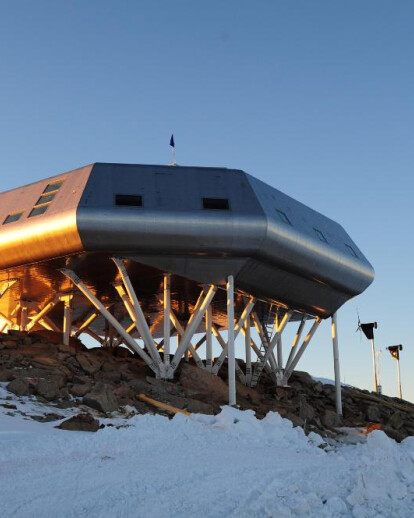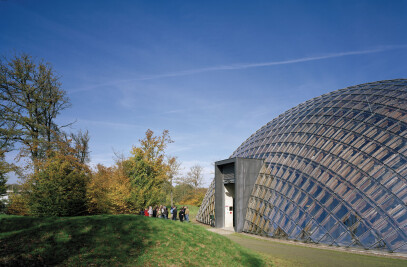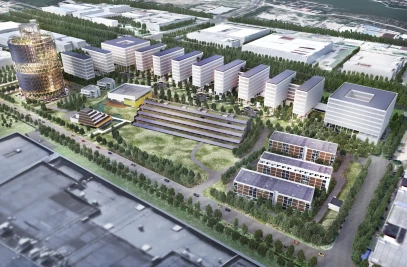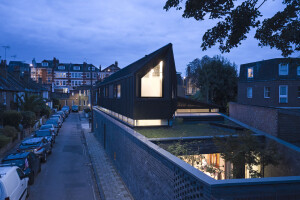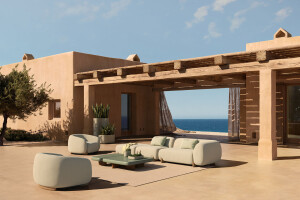The International Polar Foundation (IPF), led by the civil engineer and explorer Alain HUBERT, was commissioned in 2004 by the Belgian Federal government to design, construct and operate a new Belgian Antarctic research station. Princess Elisabeth, the world’s first “zero emission” polar station, stands now at 72°S 23°E on top of a granite ridge, north of the Utsteinen Nunatak in the Sør Rondane Mountains.
Several factors influenced the final form of the station developed by the Foundation design team led by Johan Berte and Nighat Amin, in particular:
1) The environmental conditions: extreme wind speeds, stable wind direction, very dry atmosphere, sub-zero temperatures, snow erosion and accumulation, and the potential "blasting" by grit and stone projectiles. The building has to stand at an average of 2m above the underlying ridge to prevent snow build up. The von Karman Institute for Fluid Dynamics has been closely involved in elaborating the final shape, through the establishment of the wind force distribution and intensity on the building using a wind tunnel model based on actual in situ wind velocity surveys.
2) A sustainable development approach: integration of renewable energy sources, energy efficiency and optimisation of energy flows, optimisation of materials and total waste management systems integration into the design. Energy modeling by 3E helped making this station the first ever polar station designed to generate zero emission of greenhouse gases by running entirely on renewable wind and solar energies.
3) The functional program: scientific and living spaces provided in function of the research programs likely to be run from the station.
Based on the preliminary aerodynamics and energy studies, Samyn and Partners architects and engineers have been entrusted with the task of studying the building concepts, The extremely short time-frame for the execution of the project has led to a "design and build" approach, and Prefalux (of Luxemburg) was invited into the team to accelerate the process under the control of SECO (Belgian Building Control Agency). Prefalux has already built various refined wooden structures for Samyn and Partners and the quality of their input is an established fact. Samyn and Partners has developed a sub-structure, built by the firm Iemants, composed of four steel trestles, which may expand and contract independently of each other, and which support a large wooden superstructure. The trestles are anchored in the non-uniform, surface weathered, granite bedrock and are shored by 6m deep tie-rods such as to provide a reaction to the important wind uplift experienced by the building. The anchorages have been drilled with the Smet Boring company. Not only the drilling of the station’s anchoring points was the most important part of the first building stage, but it was the most difficulty to carry out because of the composition of the rocks and their unequal disposition. The multinational construction company, BESIX, acted as overall construction coordinator on-site in Brussels for the testing phase and also in Antarctic for the final construction of the building. The envelope of the superstructure covers an orthogonal grid of trusses expanding from floor to ceiling in laminated wood elements assembled with Blumer type connectors.
The wall and roof parts of the envelope are composed, (from inside to outside) of:
• a wall covering in woollen felt; • a heavy duty Kraft paper with a thick continuous aluminium vapour barrier; • a 74mm thick multiplex wooden panel; • 400mm lightweight expanded polystyrene blocks; • a 42mm thick multiplex wooden panel (linked to the lower board by means of 6cm diameter cylindrical beech wood posts, fitting precisely in cylindrical holes in the polystyrene); • a 2mm EPDM waterproofing membrane; • a 4mm closed-cell polyethylene foam mat between the stainless steel bands located under the joints of • the final cover consisting of bolted 1,5mm thick stainless steel plates.
The floor (continuous with the upper envelope) is nearly composed in the same manner (from inside out):
• a floor covering; • a vapour barrier; • a 42mm thick multiplex wooden panel; • 400mm expanded polystyrene • a 74mm thick multiplex wooden panel resting on the structural floor beams; • a gap at the height of the beam; • a 42mm thick multiplex wooden panel on which • the EPDM membrane, • the closed cell foam and • the stainless steel cladding is fixed.
A steel plate lies between every column and connects with the continuous floor vapour barrier.
The design, concept and developed prototype were approved at the end of April 2007. The pre-assembly and testing of the whole building has been carried in Brussels during August 2007.
The final assembly and construction has taken place during January and February 2008 on site in Antarctica under the personal direction of Alain Hubert.
